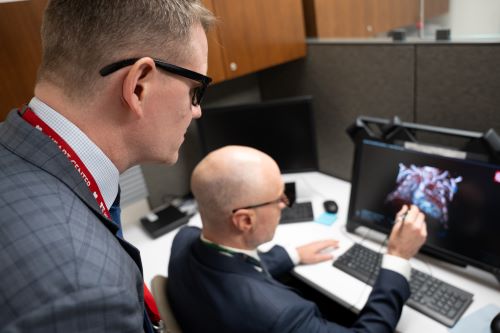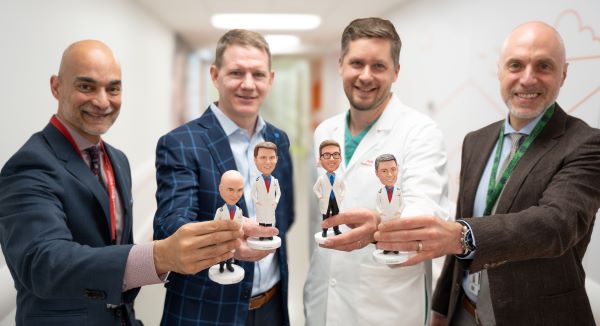Pediatric Heart Team Advances Patient Care Through Innovation and Collaboration

With 40,000 children born with a congenital heart defect each year in the United States, the value of a pediatric cardiac surgical team cannot be understated. Serving University of Utah Health’s five state area, four faculty from the Department of Surgery fill that role for the Mountain West – a region encompassing approximately 521,456 square miles.
Aaron Eckhauser, MD, MSCI; Eric Griffiths, MD; Reilly Hobbs, MD; and Adil Husain, MD, make up the team leading Intermountain Primary Children’s Heart Center, in partnership with U of U Health’s Department of Surgery. The center is a comprehensive unit that treats the most complex congenital heart conditions, with a multidisciplinary support team that includes cardiologists, ICU doctors, advanced practice providers, nurses, and more.
With a combined resume that includes more than 40 years of experience, extensive research and innovation work, and a deeply trust-focused mentality – it’s no surprise the team are leaders in their field.
Pushing the Limits of Cardiac Surgery
Through their combined efforts, the four surgeons have helped elevate the collective group at the heart center into the highly sought program it is today. In 2023 alone, the team performed more than 600 surgical cases and eight pediatric heart transplants, placing them in the top 15% in the country regarding volume and acuity.
This record clinical volume was also highlighted by excellent overall outcomes and significant growth regarding surgical care for several focused lesions. The group has embarked upon formalized naming and organization of surgical programs to address anomalous coronary arteries, multiple aortopulmonary collaterals, ventricular assist devices in the high-risk single ventricle population as well as the Ross procedure for aortic valve replacement.
“At the end of the day, our job is to provide the best care for our patients in the region,” Eckhauser said. “We have an amazing team here who work well together, and we’re all committed to helping the kids we treat have the best quality of life possible.”
Collectively, the team continues to grow the program, focusing on outcomes, patient experience, and programmatic cultural health. Their commitment to excellence is underscored by their unwavering support for both their patients and colleagues.
Keeping Trust and Care at the Heart of the Team
While the team has no shortage of technical proficiency, or institutional knowledge, with both Griffiths and Eckhauser having spent the entirety of their careers at the university, the group attributes much of their success to the culture of collaboration and trust within the team.
“We're proud of our collaborative environment,” Husain said. "Our success is rooted in mutual respect and a shared dedication to our patients' well-being."
The team’s growth and multifaceted work exemplify their commitment to innovation, patient-centered care, and professional excellence. As a team and individuals, they continue to advance the field of pediatric cardiac surgery, ensuring brighter futures for young patients battling heart disease and congenital heart defects.
Pioneering Technology and Innovation

Beyond their daily surgical duties, each surgeon has led various advancements for the heart center, which have contributed to the overall growth of the program.
Driven by concerns about the longevity of aortic valve replacements in young patients, the team evaluated ways to enhance treatment strategies. Husain, who joined the team six years ago, led the efforts, implementing the Ross procedure into their program.
The group has now become a leader in Ross procedure utilization nationally, successfully using the pulmonary valve as a replacement for the aortic valve in a vast array of pediatric cases. The introduction of the Ross program helped elevate their approach to pediatric cardiac care and led to the creation of a specialized valve clinic within the heart center.
"We wanted to provide a better product for kids," Husain said. "The Ross operation presented a streamlined solution, offering hope for improved outcomes and longevity. Our short-term outcomes are reassuring, and we're optimistic about long-term success."
In other areas of innovation, Eckhauser has done extensive training to help implement a program to treat major aortopulmonary collateral arteries, a defect that requires complex artery reconstruction. He and the team also regularly utilize advanced 3D imaging techniques to plan surgeries thoroughly before entering the operating room. The software is used to render CT scan data into detailed 3D models, allowing for precise preoperative planning.
Griffith’s, meanwhile, has been instrumental in leading the team’s efforts in implementing a ventricular assist device (VAD) program, which utilizes a mechanical heart pump in patients with end-stage heart failure.
The VAD program is pivotal for patients on the transplant waiting list, as it decreases negative symptoms from heart failure and assists the heart in pumping blood through the body more efficiently. As finding a match for a transplant can often take years, this device is vital in helping patients through the arduous process of being on the waitlist.
While Hobbs is the newest member of the team, his contributions are already monumental. In his short two and a half years with the group, he has spearheaded efforts to create an anomalous coronary artery program to treat patients with atypical coronary artery originations and course.
“Dr. Hobbs has championed the development of a comprehensive care program for patients with those specific issues,” Husain said. “We’ve never had that kind of program in the state, so it’s a huge step forward and he’s done a fantastic job with it.”
Commitment to Education
Outside of innovation, the team is acutely aware of the future of their field. When the opportunity arose to expand their team, Eckhauser, Griffiths, and Husain weighed the pros and cons of creating a fellowship or hiring an additional surgeon.
In an already oversaturated field, the group felt it was important to consider the future career options of any fellows they would have trained. Thus, the choice to create a fourth cardiac surgical position and hire Hobson allowed them to grow their team while fostering talent through alternative avenues.
“Our approach to education has really set us apart,” Eckhauser explained. “Instead of starting our own fellowship, we’ve focused on helping educate trainees from other areas who are interested in congenital heart surgery. We've also started a medical consulting group that offers leadership training for congenital heart surgeons ”
The consulting program held its first retreat in fall 2023, hosting 16 chiefs of adult heart or pediatric heart centers across the country. The team, led by Eckhauser and Husain, plan to continue amplifying their efforts to collaborate on a national scale, with a second retreat already planned for fall 2024.

Looking to the Future
While the team can’t predict the future of their field and what new changes may arise in surgical care, they remain collectively focused on providing the best care possible to help their patients live the happiest, healthiest lives possible.
With a unique focus on team collaboration and trust, they are well-prepared to continue leading the field of pediatric cardiac surgery in education, innovation, and top-tier patient-centered care.
"We're invested in shaping the future of pediatric cardiac care, but our focus extends beyond surgical expertise," Husain said. "We prioritize creating an environment where patients and families feel supported throughout their journey.”